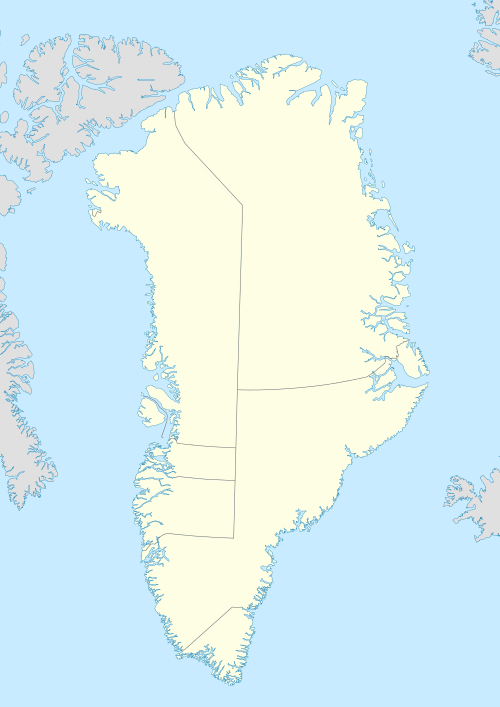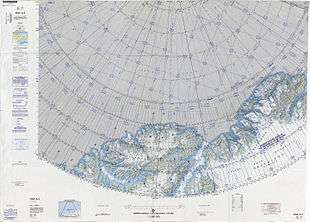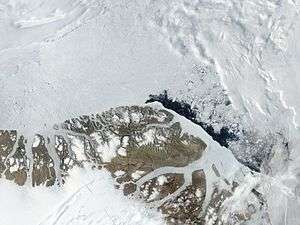Nansen Land
Nansen Land is a peninsula in far northwestern Greenland. It is a part of the Northeast Greenland National Park.[1]
 Nansen Land | |
| Geography | |
|---|---|
| Location | NW Greenland |
| Coordinates | 83°0′N 43°30′W |
| Adjacent bodies of water | |
| Length | 100 km (60 mi) |
| Width | 50 km (31 mi) |
| Highest elevation | 1,320 m (4,330 ft) |
| Administration | |
Greenland (Denmark) | |
| Demographics | |
| Population | Uninhabited |
The Arctic wolf is present in the peninsula.[2][3] The northern shore facing the Lincoln sea slopes evenly and is fertile for the area, being the northernmost limit of certain plant species.[4][5]
History
Nansen Land was named after Arctic explorer Fridtjof Nansen (1861–1930) at the time of Knud Rasmussen's Thule expeditions.[6]
American geologist William E. Davies called the wider range north of J.P. Koch Fjord and Frederick E. Hyde Fjord the "Nansen-Jensen Alps", with the westernmost foothills in Nansen Land, stretching past the De Long Fjord area across Roosevelt Land and the Roosevelt Range, and reaching all the way to Johannes V. Jensen Land in the east.[7]
Geography
Nansen Land is located to the northeast of Freuchen Land, east of Sverdrup Island, and west of West Jensen Island and Amundsen Land. The westernmost headland is Cape Payer and the northernmost headland is Cape Mohn, the northern end of an island at the entrance of De Long Fjord, separated from Nansen Land by a narrow sound.[4]
The peninsula is bounded to the west by the Mascart Sound, to the southwest by the J.P. Koch Fjord and to the east by the Brainard Sound (82°57′N 41°40′W) and Thomas Thomsen Fjord, a branch of the De Long Fjord system. The peninsula is cut by faults roughly from east to west. To the southeast lies the Hans Tausen Ice Cap and to the south the Sirius Pass, a broad valley connecting J.P. Koch Fjord in the west and Brainard Sound in the east in the area where the peninsula is attached to the mainland and its ice cap.[8]
Northwestern Nansen Land is deeply indented on its Lincoln Sea shore. The main indentations are Jewell Fjord and Gardiner Fjord.[1] The interior is mountainous and partly glaciated.[9] Elevations reaching 1,320 metres (4,331 ft) are found in the central part of the peninsula.[4]
 Map of part of Ellesmere Island and far Northern Greenland. |
 Satellite image of the northern end of Greenland. |
Bibliography
- H.P. Trettin (ed.), Geology of the Innuitian Orogen and Arctic Platform of Canada and Greenland. 1991
See also
References
- "De Long Fjord". Mapcarta. Retrieved 6 October 2019.
- Food Habits of Arctic Wolves in Greenland
- Endoparasites of Arctic Wolves in Greenland
- Prostar Sailing Directions 2005 Greenland and Iceland Enroute, p. 95
- Northern Limits Attained by British Plants
- Sam Alley. "Knud Johan Victor Rasmussen". Minnesota State University. Archived from the original on 12 October 2010. Retrieved 1 June 2017.
- W. E. Davies, Landscape of Northern Greenland 1972
- Geology of Nansen Land
- GoogleEarth
External links
- Palaeomagnetism of three dyke swarms in Nansen Land, north Greenland (83° N)
- The Earliest Annelids: Lower Cambrian Polychaetes from the Sirius Passet Lagerstätte, Peary Land, North Greenland
- Greenland Pilot